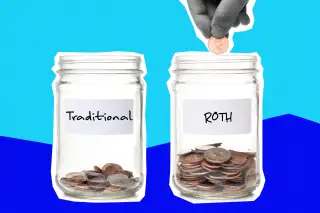Got an IRA? Here's How to Use the Bear Market to Your Advantage

Wall Street might be swimming in a sea of red ink, but for retirement savers, there is a silver lining to the recent stock market slide: If you have a traditional individual retirement account, or IRA, converting it to a Roth IRA while sentiment is bearish can deliver major tax savings.
"In financial planning, there is no silver bullet, but it could be a very useful tool," says Clark Kendall, president and CEO of Rockville, Maryland-based wealth management firm Kendall Capital.
As Money readers know, a traditional IRA is a tax-deferred investment vehicle funded with pre-tax dollars. After age 59 1/2, you pay income tax on withdrawals; for many, this makes sense because they assume retirement will put them into a lower tax bracket. Conversely, a Roth IRA is funded with after-tax dollars, meaning you pay up front so you can take tax-free withdrawals after age 59 1/2.
But it's possible to convert a traditional IRA to a Roth IRA. And this summer might be the perfect time to do just that.
Being opportunistic about circumstances that temporarily depress either your income or the value of your invested assets can save you on your tax bill in the long run. For example, the number of Roth conversions jumped in 2020 as Americans who were laid off or furloughed because of the pandemic took advantage of their dip into a lower tax bracket that the loss of income triggered.
Now, the stock market's recent tumble into bear market territory could have the same effect. By decreasing the value of your investment, it's effectively slashing your tax obligation.
“Markets are down and values of portfolios are down, so if you did the conversion and had to pay taxes, you’d pay a lesser amount because the value of your traditional IRA is lower,” says Robert Conzo, CEO of investment advisory firm The Wealth Alliance in Melville, New York. "If you had $200,000 in a traditional IRA that’s now worth $150,000, you’re going to be paying a lot less tax."
What to know before converting your IRA
One important caveat to the above advice: You'll have to pay income tax on the funds you convert, so you'll need to have enough money in cash to pay that bill.
If you have to liquidate a portion of your IRA to cover the taxes, you’ll face a penalty for early withdrawal, and you’ll (possibly) be selling at a loss. Many people conduct conversions in stages so they don't take the income tax hit all at once, since claiming the entire balance of a traditional IRA on a single year's income easily could bump you into a higher tax bracket.
But assuming you have the savings to cover the taxes, it could be a smart move.
That's especially true when you consider the skyrocketing inflation in the U.S. Although savings rates on deposits have begun ticking up, the returns on even high-yield savings vehicles pale in comparison to the runaway inflation rate. Paying off what would otherwise be a future tax obligation could be a better use of your dollars than the paltry returns they could yield if they were sitting in, for example, a money market account.
A Roth conversion now also might make sense if you think your income tax rate will increase in the future. The 2017 Tax Cuts and Jobs Act included lowered individual income tax rates temporarily, but those cuts are set to expire after 2025 unless Congress intervenes.
And in the face of rising government debt — and an interest-rate environment that could make servicing that debt more expensive — Kendall makes the case that taxes are likely to rise in the future even if Americans get a reprieve come 2026.
"They could actually be in a higher tax bracket when they retire," he says.
To get started with an IRA conversion, determine how much you plan to convert and calculate the tax to determine if a conversion is financially feasible for you. If the math works, you will need to open a Roth IRA, which you can do through a brokerage, bank or other financial institution. Then contact the administrator of your traditional IRA to find out what paperwork they require.
More from Money:
Why You Should Open an IRA in Addition to Your Workplace 401(k)
This Smart Savings Trick Can Help Teenagers Qualify for More College Financial Aid
Investors Are Betting Their Retirements on Bitcoin. And, Yes, That Is Very Risky